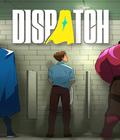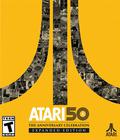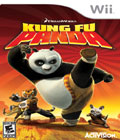Genre: Action/Adventure
Publisher: Activision
Developer: Luxoflux
Release Date: June 3, 2008
Movie tie-in games are, in some ways, the bane of a video gamer's existence. No matter what the movie is, no matter how well it would adapt to being a video game, no matter how much effort or time is put into it, they seem to end up universally bad. It comes as a shock when a movie tie-in turns out to be playable, let alone good, and these low expectations fall even further when it involves a children's title. A game based on a hit animated movie would sell a million copies even if they forgot to put the disc in the case. I must admit that I didn't have the highest expectations for Kung Fu Panda, based on Jack Black's latest cinematic venture. Yet something funny happened once I started playing Kung Fu Panda. Around the third or fourth stage, I took a brief break and realized that I hadn't had a single moment of frustration, boredom or anger. Indeed, I was actually quite — dare I say — happy with what I was playing. Luxoflux's Kung Fu Panda, while far from flawless, turned out to be one of the better children's titles I've ever played.
Kung Fu Panda tells the story of a panda named Po, who isn't exactly hero material. He's overweight, childish and seems doomed to spend the rest of his life in his father's noodle shop while dreaming of his kung fu idols, the Furious Five. When Po discovers that the Furious Five are holding a martial arts tournament, he simply has to go and see it. A bundle of mishaps later, Po is accidentally named the heir to the Dragon Warrior title, signifying him as the premier martial artist in the land. He must now train with the Furious Five and their master, Shifu, to live up to his new title before the disgraced warrior Tai Lung can return to claim the name and power of the Dragon Warrior for himself. It's not exactly an innovative or new storyline, but Po manages to be a fairly charming and amusing protagonist. Most of the plot is bare-bones at best, since it is, after all, a movie adaptation, and they want you to see the whole story in theaters, not on your Xbox 360, but there's enough detail that even those who've never seen the movie can follow the plot quite easily. One can't imagine why you'd play Kung Fu Panda without seeing the movie first, but you never know.
Most of Kung Fu Panda is built around controlling Po, the titular panda, as he fights his way through the armies of the evil Tai Lung. The best way to describe Kung Fu Panda's combat is a sort of child-friendly Ninja Gaiden. The X button unleashes a fast attack, the Y button a strong attack, and combinations of the two allow Po to utilize a small variety of combos. The Left Trigger blocks, which activates a Smash Bros.-style shield of energy around Po that slowly shrinks as you hold the button or take damage. Press a direction and block at the same time, and Po will backflip or roll out of the way of an attack. Finally, Po's unique panda kung fu moves can be activated by pressing the B button; unsurprisingly, these moves are built around using Po's tremendous weight to demolish his enemies. The moves are context-sensitive as well, so there is no switching between abilities. For example, press B in the air and he'll unleash a Panda Quake, which devastates nearby enemies, but if you press it on the ground, he'll fall into a Panda Stumble and roll over any nearby foes like a boulder. These panda kung fu moves can't be used at will, and each one requires some of Po's Chi energy, which can only be refilled by defeating enemies.
Kung Fu Panda's combat system is surprisingly involved. You can juggle enemies, perform counter-attacks, unleash different combos and generally do a wide variety of moves. The unfortunate part is that Kung Fu Panda's child-friendly gameplay means that you'll rarely use most of these. You can get through 90 percent of the fights by spamming the X button and occasionally throwing in a Panda Quake or Iron Belly technique. This makes the title quite easy for children to play, but anyone who sees the combat system and expects anything more than a button masher is going to be a bit disappointed. With that said, the combat system allows gamers who want to play around to do so. If a player wants to juggle enemies in the air or send them flying, he can do that. It's just far from necessary to do so to advance.
The nice thing about Kung Fu Panda is that each of the stages focuses on something different. Instead of the pointless button-mashing that would usually be found in a children's game, you'll find that Kung Fu Panda ensures that you'll find something different in each level. One stage, for example, may require you to simply beat your way through a large group of enemies. The next may put you in control of Crane and require you to play a rail-flying segment, where you dodge storm clouds and enemy crows. The next might have you in control of Tigress as she battles a boss in a God of War-style cut scene fight, or Po having to defend the Palace of Peace from invading thieves who try to steal its rare treasures. While none of the goals are particularly complex, they give each stage a unique feel. They tend to be simple and forgiving enough for younger children, but complex enough that older children won't get bored by senseless button-mashing.
Particularly well designed are the stage goals. Kung Fu Panda is very forgiving as far as completing the stage goes. In the stages where you have to collect items, you can complete the stage simply by collecting about 60 percent or so of the required items, so kids who don't enjoy searching for that one missing firework will be fine with 10 of 16. Furthermore, each stage tends to have optional objectives, such as rescuing trapped villagers or completing the stage within a certain time, which don't need to be completed at all. However, if your child (or you) is the kind of gamer who loves tracking down every little aspect, the game rewards you with a higher ranking and achievements for completing each stage 100 percent. Beyond the optional objectives, you'll also find hidden rare coins and trophies throughout the stages, which unlock concept art, bonus characters and even new multiplayer game types.
Kung Fu Panda's multiplayer is an admirable attempt that falls a bit flat in execution. There are a few different options available to you. Brawling allows you to take any of the characters you've unlocked during the single-player game and compete against one another in a four-player fight using the game's combat engine. It feels a bit like Super Smash Bros., although obviously nowhere near as polished. Brawling is fun but not particularly well balanced, and certain characters are overpowered to the point that if someone selects one of them, you might as well not even try to win. For those players who want to pit Po against the Tigress, you'll enjoy it, but it won't last long. The other multiplayer games are basically glorified mini-games, such a bizarre Kung Fu Panda take on Othello, which are fun, but are not going to keep anyone returning to the game after one or two tries.
Kung Fu Panda is really quite a visual treat. The character models are expressive and very well-animated. While they're not perfect, and there are some odd graphical glitches in places, it mostly feels like you're playing scenes from the movie. The levels are also quite bright and well-designed, although sometimes a bit too similar. You'll also notice quite a few reused levels, which makes sense for the plotline, but it is sort of disappointing to return to a slightly modified version of the same level that you've already seen. Luckily, the various objectives prevent these stages from feeling repetitive. Likewise, the audio aspect is quite good, if not perfect. The soundalike actors do an admirable job of mimicking their respective actors, to the point where I could actually identify which actor they were supposed to be without knowing beforehand. Overall, it's a solid presentation on all levels.
There is, however, one problem that keeps Kung Fu Panda from being a solid purchase for younger children, and that is its short length. Kung Fu Panda can probably be finished in under four hours, and even younger children will probably take no more than five hours to complete the entire game, and that is assuming that they're attempting to complete each level 100 percent. Once you've completed Kung Fu Panda, there isn't really much to make you replay the single-player campaign, and the multiplayer's lack of online play and generally limited gameplay means that it isn't going to keep kids busy for that long either. Even at the cheaper-than-usual $49.99, Kung Fu Panda is too little content for too much money. It's certainly quality content, especially for a movie tie-in children's game, but any parents looking at this title for their kids will want to be sure that it is the most prudent use of their money.
As far as children's movie tie-in games, Kung Fu Panda a rare title that reaches the top of the barrel. It's well-designed, keeps the gameplay fresh, looks and sounds great, and appears to be a game that the developers actually tried to make into something fun, rather than selling it because the cover boasts the mascot of the week's popular cartoon character. Kung Fu Panda isn't perfect. The low difficulty level, short length and lack of replay value mean that it isn't going to be a lasting experience for young gamers, and the minimal multiplayer does little to impart any lasting value. If you can swallow the $49.99 price tag, Kung Fu Panda is an admirable attempt that is sure to please young fans of the movie, although older gamers will find little to satisfy them here.
Score: 7.5/10
More articles about Kung Fu Panda











 In the Kung Fu Panda video game, players embark on an epic, action-packed adventure as they master the specialized Kung Fu fighting styles of Po the Panda, the unlikely hero, his teacher Shifu, and the legendary Kung Fu masters, the Furious Five: Monkey, Tigress, Viper, Mantis and Crane. Through 13 legendary levels from the movie and beyond, and spanning land, water and air, players must work their way to become the Dragon Warrior and defeat the ultimate enemy, Tai Lung, as they battle a variety of foes, overcome dangerous obstacles, navigate multi-tiered environments and solve challenging puzzles.
In the Kung Fu Panda video game, players embark on an epic, action-packed adventure as they master the specialized Kung Fu fighting styles of Po the Panda, the unlikely hero, his teacher Shifu, and the legendary Kung Fu masters, the Furious Five: Monkey, Tigress, Viper, Mantis and Crane. Through 13 legendary levels from the movie and beyond, and spanning land, water and air, players must work their way to become the Dragon Warrior and defeat the ultimate enemy, Tai Lung, as they battle a variety of foes, overcome dangerous obstacles, navigate multi-tiered environments and solve challenging puzzles.















